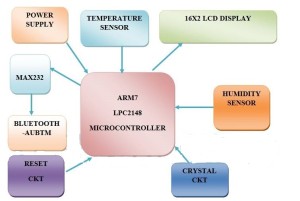ABSTRACT
Mobile devices (in particular Smartphones and tablets) can be used to monitor quality of life parameters. Today mobile devices use embedded sensors such as accelerometers, compasses, GPSs, microphones, and cameras without considering, for example, the air quality or the pollutants of the environment. This paper presents the possibility to use the Smartphones capabilities to gather data from other phones or sensors. Nowadays, monitoring climate condition’s parameters such as temperature and humidity is a prominent factor to control the changes of the environmental condition of living or working places for the human being. This point can be obtained by using distributed devices in different environments that containing high-resolution sensors and a wireless transmission apparatus for transferring data to Smartphones. The Bluetooth was chosen as a transmission tool since it is embedded in all Smartphones and it can work in the absence of the Wi-Fi connection. Smartphones are the programmable tools to have different kinds of applications that allow communicating with other devices and also gathering, analyzing and verifying data. In this paper, a novel interface by applying a Bluetooth-based sensor to sense Temperature and Humidity for monitoring of the environmental conditions using the android-based Smartphone is introduced..
PURPOSE:
Environmental sensors, such as temperature, humidity, smoke, gases, solar radiation, pressure, and so on, can be placed both in outdoor and indoor sites. There are environmental sensors that monitor some specific elements such as CO2, O2, H2, and so on. In most cases, this kind of sensor network is organized as a short distance transmitter of data. Low power and low cost are the main characteristics of these sensors. The following parameters will be affected on the sensors structures and subsequently their platforms:
- Deployment (activities)
- Location (indoor / outdoor)
- The application
- Data (that should be processing and inferring)
The Bluetooth-based temperature and humidity acquisition system consists of a device comprising a sensor and a microcontroller that wirelessly transmits these climatic parameters to a receiver using the Bluetooth communication system. An application called a Blue control was developed to acquire data from the Bluetooth-based temperature and humidity acquisition system that has described before. The Blue control application has two parts. The first part, display, illustrates the temperature and humidity values that are read from the Bluetooth-based acquisition system, which is first configured in the second part called setting. The obtained values can be saved in a text file to allow the analysis of the data.
POWER SUPPLY:
BLOCK DIAGRAM:
TRANSMITTER SECTION:
RECEIVER SECTION:
SOFTWARE AND HARDWARE TOOLS:
Software Tools:
- KEILUV4 IDE TOOL
- ISP PROGRAMER
- EMBEDDED C PROGRAMMING
- FLASHMAGIC
Hardware Tools:
- ARM7TDMI LPC2148
- MAX232
- LCD DISPLAY
- BLUETOOTH
- POWER SUPPLY
- GAS SENSOR
- TEMPERATURE SENSOR
- HUMIDITY SENSOR
- COOLING FAN
- DRIVER IC
RESULT:
This paper investigates a novel approach to acquire temperature and humidity signals using relative low cost and low power components and the Bluetooth communication system for the transmission of the acquired data to an android based Smartphone. An application for the acquisition and storage of temperature and humidity values was created for the android’s Smartphone. The performance of the entire system was tested by laboratory tests using a climate chamber in order to modify the environmental conditions. Results shown that the presented device correctly follows the environmental condition which created by the climatic chamber and the application for the Smartphone properly acquired and stored the data by the apparatus using the Bluetooth connection as a transceiver. This approach is useful to monitor climate condition for small environments, such as a laboratories, home rooms, medical spaces, etc., and turn on alarms when the condition changes or overlaps some fixed thresholds. Another possible application of the presented system is the detection of fire in small environments.














Post Comment
You must be logged in to post a comment.